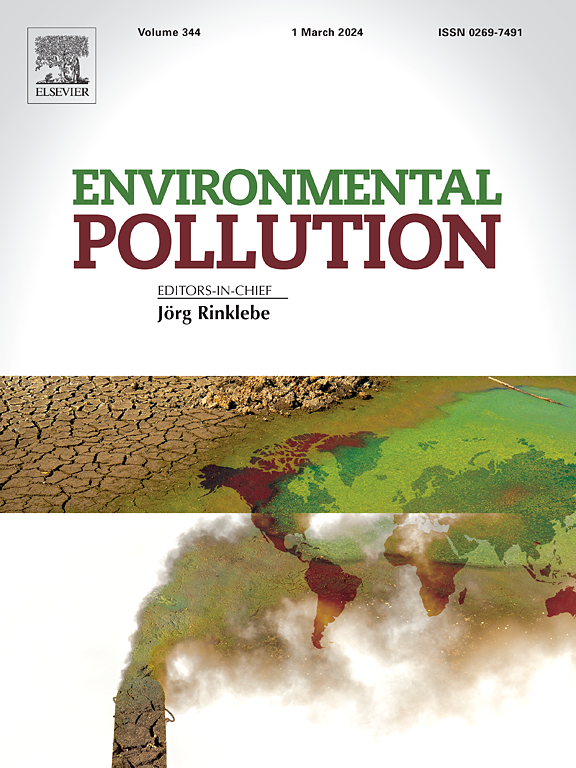Tracing emerging contaminants from the Baltic Sea and North Sea in fjord waters in southern Norway with rare earth elements as far-field tracers
IF 7.3
2区 环境科学与生态学
Q1 ENVIRONMENTAL SCIENCES
引用次数: 0
Abstract
Knowledge of geogenic and anthropogenic rare earth elements and yttrium (REY) in fjords in Norway and elsewhere is still limited despite the importance of fjords for biodiversity and economy and the known ecotoxicity of the REY. We provide complete sets of REY data for fjord waters and a river in southern Norway and for several stations along the coasts of Denmark and Sweden, which characterise Baltic Sea outflow water.
Shallow fjord waters show high REY concentrations and shale-normalised (SN) patterns that resemble those of the river water input. Deeper waters show lower concentrations, seawater-like REYSN patterns, and the PrSN/TbSN ratios (≥0.5) typical of fjord waters. Some of the samples show elevated Gd/Tb ratios and distinct positive Gd anomalies, revealing the presence of anthropogenic Gd originating from constrast agents used in magnetic resonance imaging (MRI).
We emphasise that all water samples from the Baltic Sea outflow taken over a twelve months period show large positive Gd anomalies, suggesting a permanent flux of anthropogenic Gd from the Baltic Sea into the Skagerrak. Combined with literature data, our results suggest that the anthropogenic Gd in the fjords of southern Norway is not derived from local sources. It rather originates from the Baltic Sea and southern North Sea and is transported northward by currents along the coasts of Sweden, Denmark and Germany. If application of Gd-based contrast agents in MRI continues to increase, this signal will get stronger in the future and be transported even further north.
Overall, our data for geogenic REY and anthropogenic Gd in fjord and bay waters from southern Norway and in the Baltic Sea outflow show that local hydrography exerts an important control on the concentration and distribution of trace elements which may be (micro)nutrients and/or (micro)pollutants in fjords. This needs to be considered in environmental impact studies.


用稀土元素作为远场示踪剂追踪来自挪威南部波罗的海和北海峡湾水域的新兴污染物
尽管峡湾对生物多样性和经济的重要性以及已知的生态毒性,但对挪威和其他地方峡湾的地质和人为稀土元素和钇(REY)的了解仍然有限。我们为挪威南部的峡湾水域和一条河流以及丹麦和瑞典沿岸的几个站点提供了一整套REY数据,这些数据是波罗的海流出水的特征。浅海峡湾水体REY浓度高,且具有与河流输入水体相似的页岩正态(SN)模式。较深水域呈现较低浓度,REYSN模式与海水相似,PrSN/TbSN比值≥0.5为典型的峡湾水域。一些样本显示Gd/Tb比率升高和明显的Gd阳性异常,表明磁共振成像(MRI)中使用的造影剂存在人为Gd。我们强调,在过去12个月的时间里,波罗的海流出的所有水样都显示出巨大的正Gd异常,这表明波罗的海的人为Gd永久输入到斯卡格拉克。结合文献资料,我们的研究结果表明,挪威南部峡湾的人为Gd不是来自当地来源。它起源于波罗的海和北海南部,并被洋流沿瑞典、丹麦和德国海岸向北输送。如果MRI中基于gd的造影剂的应用继续增加,该信号将在未来变得更强,并向北传输。总的来说,我们在挪威南部和波罗的海流出的峡湾和海湾水域的地质REY和人为Gd数据表明,当地的水文对峡湾中微量元素的浓度和分布有重要的控制作用,这些微量元素可能是(微)营养素和/或(微)污染物,需要在环境影响研究中加以考虑。
本文章由计算机程序翻译,如有差异,请以英文原文为准。
求助全文
约1分钟内获得全文
求助全文
来源期刊

Environmental Pollution
环境科学-环境科学
CiteScore
16.00
自引率
6.70%
发文量
2082
审稿时长
2.9 months
期刊介绍:
Environmental Pollution is an international peer-reviewed journal that publishes high-quality research papers and review articles covering all aspects of environmental pollution and its impacts on ecosystems and human health.
Subject areas include, but are not limited to:
• Sources and occurrences of pollutants that are clearly defined and measured in environmental compartments, food and food-related items, and human bodies;
• Interlinks between contaminant exposure and biological, ecological, and human health effects, including those of climate change;
• Contaminants of emerging concerns (including but not limited to antibiotic resistant microorganisms or genes, microplastics/nanoplastics, electronic wastes, light, and noise) and/or their biological, ecological, or human health effects;
• Laboratory and field studies on the remediation/mitigation of environmental pollution via new techniques and with clear links to biological, ecological, or human health effects;
• Modeling of pollution processes, patterns, or trends that is of clear environmental and/or human health interest;
• New techniques that measure and examine environmental occurrences, transport, behavior, and effects of pollutants within the environment or the laboratory, provided that they can be clearly used to address problems within regional or global environmental compartments.
 求助内容:
求助内容: 应助结果提醒方式:
应助结果提醒方式:


